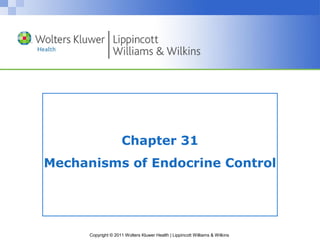
Mechanisms of Endocrine Control: Hormones, Cells, Glands
- 1. Chapter 31 Mechanisms of Endocrine Control Copyright © 2011 Wolters Kluwer Health | Lippincott Williams & Wilkins
- 2. Hormones • Hormones make cells react by attaching to receptors on their membranes • A cell will only respond if it has receptors for the hormone. – Up-regulation: the cell makes more hormone receptors – Down-regulation: the cell makes fewer hormone receptors • Different cells respond differently to the same hormone Copyright © 2011 Wolters Kluwer Health | Lippincott Williams & Wilkins
- 3. Hormones (cont.) Hormones can affect cells nearby or far away. Copyright © 2011 Wolters Kluwer Health | Lippincott Williams & Wilkins
- 4. Copyright © 2011 Wolters Kluwer Health | Lippincott Williams & Wilkins Question Your patient has low levels of circulating thyroid hormone. How will the cells of the thyroid gland respond? a. No response b. Response will depend upon the levels of TSH. c. Down-regulation d. Up-regulation
- 5. Copyright © 2011 Wolters Kluwer Health | Lippincott Williams & Wilkins Answer d. Up-regulation When there is diminished hormonal activity, cells have the ability to make more hormone receptors and increase the sensitivity of the existing receptors to the hormone. This is called up-regulation.
- 6. Hormones (cont.) Hormones can be made of: • Amino acids – Epinephrine, dopamine, T3, and T4 • Proteins (peptide hormones) – Insulin, glucagon, trophic hormones • Cholesterol (steroid hormones) – Cortisol, aldosterone, testosterone • Fatty acids – Ecosanoids Copyright © 2011 Wolters Kluwer Health | Lippincott Williams & Wilkins
- 7. Copyright © 2011 Wolters Kluwer Health | Lippincott Williams & Wilkins Question Tell whether the following statement is true or false: Steroid hormones are all derived from cholesterol.
- 8. Copyright © 2011 Wolters Kluwer Health | Lippincott Williams & Wilkins Answer True The adrenal sex hormones, glucocorticoids, and mineralocorticoids all arise from cholesterol and have similar chemical structures even though their functions are slightly different.
- 9. Scenario A man takes dopamine for paralysis caused by his Parkinson disease… • At first a small dose of dopamine was all he needed • His symptoms improved significantly right after taking it, but then he froze up again • Now he needs a high dose, and the effects last only a little while Question • What has happened to his cells and their receptors? • The doctor has decided to try giving him an MAO inhibitor along with his dopamine. Why? Copyright © 2011 Wolters Kluwer Health | Lippincott Williams & Wilkins
- 10. After Hormones Affect Body Cells • They may be destroyed by enzymes at the receptor site – Epinephrine, dopamine • They may be taken up by cells and destroyed – Peptide hormones • They may be destroyed in the liver and passed out in the bile – Steroid hormones – T3 and T4 Copyright © 2011 Wolters Kluwer Health | Lippincott Williams & Wilkins
- 11. Copyright © 2011 Wolters Kluwer Health | Lippincott Williams & Wilkins Scenario A man with liver failure has developed… • Hypokalemia • Hypotension • Hyperglycemia • Repeated infections Question • What hormone imbalances do you suspect? Why?
- 12. Hypothalamus Hypothalamus knows the state of the body: • Temperature • Blood osmolarity • Blood nutrients • Blood hormone levels • Inflammatory mediators in blood • Emotions • Pain Copyright © 2011 Wolters Kluwer Health | Lippincott Williams & Wilkins
- 13. Copyright © 2011 Wolters Kluwer Health | Lippincott Williams & Wilkins
- 14. Pituitary (Master Gland) Creates Trophic Hormones Hypothalamus makes releasing hormones Copyright © 2011 Wolters Kluwer Health | Lippincott Williams & Wilkins They tell other endocrine organs in the body to grow and secrete their hormones Which are sent to the anterior pituitary The anterior pituitary releases its stored trophic hormones into the systemic circulation (Image reproduced from Bowne, P.S. [2004]. CRH release tutorial. Used with author’s permission.)
- 15. Copyright © 2011 Wolters Kluwer Health | Lippincott Williams & Wilkins
- 16. Copyright © 2011 Wolters Kluwer Health | Lippincott Williams & Wilkins
- 17. Copyright © 2011 Wolters Kluwer Health | Lippincott Williams & Wilkins Question Tell whether the following statement is true or false: The pituitary gland controls the release of thyroid hormone.
- 18. Copyright © 2011 Wolters Kluwer Health | Lippincott Williams & Wilkins Answer True The pituitary gland (on a cue from the hypothalamus) tells other organs or glands to produce and secrete or inhibit the appropriate hormones.
- 19. Copyright © 2011 Wolters Kluwer Health | Lippincott Williams & Wilkins Discussion A man’s hypothalamus has no hormone receptors. • What will happen to his production of: – CRH T3 and T4 – ACTH FSH – Cortisol LH – Testosterone GnRH – TRH TSH Question • What signs and symptoms do you expect him to have?
Editor's Notes
- Author: Add text?
- Author: Please add title.
- Author: Please add title.
- Author: Please add title.